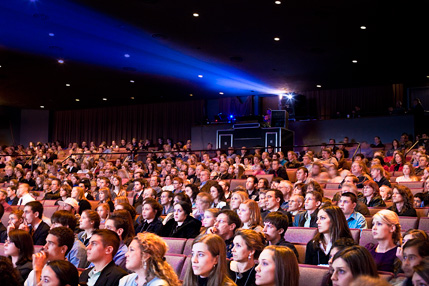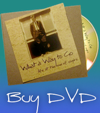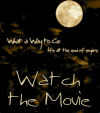COMMUNITY SCREENING GUIDELINES

Decide on Venue, Date and Time
Possible Venues:
Independent movie theater,
Church,
Library
,Community Center,
University lecture hall.
Independent theaters: Usually have a pretty steep fee but occasionally they will split the door 50/50 if they believe in the mission or believe they can make more with that arrangement. If you can get a large crowd it is usually the most comfortable seating and if they have digital projection/sound it is usually the easiest venue technically. Downsides are the cost and the difficulty bringing people into a circle for dialogue conversation after.
Community Venues: Can be booked for small/no charge. Churches often have relatively comfortable seating. What A Way To Go is two hours. We have had successful screenings on hard chairs but it is asking a lot for some people. In community venues there is often need to borrow, or rent, and set up projection and sound systems. However, more and more churches and libraries are starting film series so that may not be an issue. Sometimes getting the room darkened is a challenge. Upsides of community venues are usually the lower cost and the ease to move into a circle for dialogue after.
Obtain a Screening License
Buy one on our Community Screening License Purchase Page.
If your expected attendance is 60 or less the cost for a one-time community screening license is $50. This fee goes to support our on-going work in the world and to pay for the initial investment costs of the movie. The community screening license is not intended for screenings where a set admission is charged or where larger groups of people will be seeing the movie. Rather it is intended to support community groups. You can certainly suggest a donation amount and advertise it as a fundraiser.
Admission prices: You can take donations to cover your costs and we encourage you to do so. If your group needs to raise funds you can advertise the screening as a fundraiser. We ask that you split the proceeds after paying for expenses 50/50 with us.
Promote the Event
Let us know the details! We will post your screening on our website. Email us the following information:
Town/City and State, Date, Time, Name of Venue, Street address, Suggested donation, Sponsoring Organization(s), Contact person & contact email/phone #.
CLICK HERE for promotional materials, posters, email samples, images, postcards, etc. Email invitations and reminders are easiest and we offer you templates to plug your screening information into which makes it even easier.
Sponsors: Enlist other groups to sponsor the event and forward them the email you’ve created. You can also offer to allow them to set up an information table at the screening. They might even be willing to help set up the event and share costs. But just having them do email promotion is worth listing them as sponsors.
Press: Get listed in upcoming events as far in advance as your local newspaper allows. Also try to get or write your own reviews or articles for local papers or newsletters. If you write an article about the screening it can tie into other re-localization efforts, CSA & farmers markets, co-ops, co-housing, intentional community, etc. Contact editors about doing a pre-screening news story.
Ask everyone you know to send announcements/ invites/ and reminders to their email lists.
Tech Stuff
Technical details: It is always wise to check technical details such as projection and sound at least a few days ahead of time so if there is a problem you have time to remedy it. Then again it is good to arrive at least an hour ahead to be sure everything is working.
• Screens: We’ve screened on a variety of screens. Big screens are nice, of course, if you can get one, but not required. In many settings a smaller screen works fine. (We used a wall in one venue, which worked well, but the room had a low ceiling, so there were limits as to how high the picture could be raised.) Getting the screen high enough that audience members aren’t looking through the head of the person in front of them is important. Some older projection screens have a tendency to slump and wrinkle, and that can be distracting to the eye, as it distorts the picture and creates bright spots.
• DVD Player: We’ve noticed some clarity issues when a laptop was used as the DVD player. Some laptop monitors display lots of artifacts when playing DVDs. You’ll notice lower clarity, weird movement, jerky fades, and sometimes the picture and sound don’t sync together well. Stand-alone DVD players HAVE NOT had any of these problems.
• Sound: IN MANY WAYS SOUND IS MORE IMPORTANT THAN PICTURE!
The WAWTG DVD has a stereo soundtrack that was not professionally mastered so it is not always perfectly balanced. The best speaker systems are independently powered stereo systems, such as a home stereo system in the 50 to 100 watt range. A single powered speaker, like a PA unit, is not enough. You need two speakers, to get the full sound. The best speaker placement has the speakers at the front of the room, up on chairs or tables or stands so the sound is not blocked by the front row of the audience, on either side of the screen, pointing back toward the audience. (Even better is a four-speaker system, with two speakers up front and two speakers half-way back.)
• Small computer speaker systems almost never do the job. Bringing good sound to a room full of people is a very different task than simply bringing audible sound to an empty room. Being able to hear the soundtrack from the back of an empty room is not an adequate test. For the documentary to have its full effect, you need rich, full sound that is loud enough even with a room full of people.
THE EVENT!
Introduction: Thank people for coming. Thank the people who helped and who sponsored the event. Tell people there will be a facilitated dialogue following the movie that they are welcome to stay for, and that they can choose whether they wish to speak or not. Keep this intro short as people are here to see the movie.
Show the Movie!
Post Screening Dialogue Conversation
We have found that dialogue after a screening of What a Way to Go can help people grasp the information and connect with others. This initial dialogue we’ve found is best not for plans of action but for beginning to create a galvanized group that may choose to continue to meet to figure out how to create the change they want, both as individuals and as a growing community. These conversations often last an hour or two so it is wise to plan to have time available in the venue.
Follow Up
You or your group may want to have a sign up list available and even pass it around the dialogue circle toward the end of the evening. Groups help people to support one another in staying “awake,” to process through despair and grief, to take local actions, and seek greater wisdom together.
Wrap Up
We’d love a short note about how the screening went. If you were able to raise funds beyond the cost of throwing the screening, please remember to support our work so we can keep supporting yours! You can make that CONTRIBUTION HERE or mail a check to VisionQuest Pictures, 3 South Street, Eastport, ME 04631.





